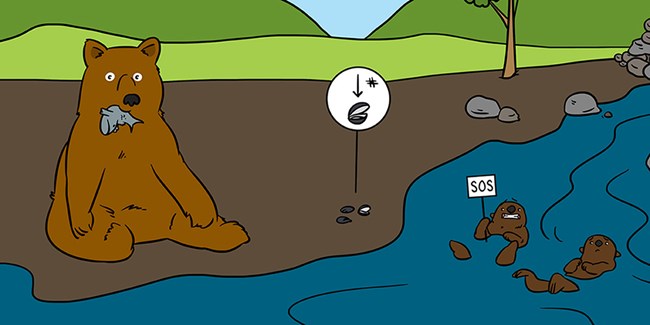
NPS/Deb Kurtz
Katmai National Park and Preserve, renowned for its brown bears, is also home to a thriving sea otter population. Once hunted to near extinction across its range, the sea otter has recovered across large swaths of its former habitat, including coastal Katmai. These two top-level predators overlap in ways we did not necessarily expect.
Brown bears are generalist predators that take advantage of a wide variety of prey items. Brown bears that live on the coast have even more options, as the ocean offers a bounty when the tide falls. Brown bears dig for and eat clams from the tidal flats, catch flounder in the nearshore shallows, and scavenge whale carcasses.
Sea otters can wiegh up to 100 pounds. They are important to nearshore food webs because they feed on clams, crabs, and urchins. They are especially important to keep the sea urchin population in check so that urchins don't overgraze kelp beds.
Recent evidence has shown that brown bears are hunting sea otters off the coast of Katmai National Park and Preserve where sea otters have off-shore haul-outs. Future studies should focus on the effects these top-level predators have on each other and how they may change over time.
Learn More

Credit: Frontiers for Young Minds
Where Land and Sea Meet: Brown Bears and Sea Otters
In Katmai National Park, Alaska, we have seen changes in the number of brown bears and sea otters. The number of animals of a species a habitat can support is called carrying capacity. Even though bears live on land and sea otters live in the ocean, these two mammals share coastal habitats. Bears eat salmon, other fish, plants, clams, and beached whales. Sea otters feed on clams and other marine invertebrates. All these foods are influenced by the ocean. Recently, we have seen fewer bears but more sea otters! What changed? Many things, but several observations point to the ocean. There are fewer salmon, whales, and clams, so bears rely more on plants for food. Fewer clams mean sea otters must work harder to find food. Our studies are helping us to understand how and why carrying capacity for a given species may change over time.
Also see: sea otters and brown bears in Southwest Alaska
Coletti, H., G. Hilderbrand, J. Bodkin, B. Bellachey, J. Erlenbach, G. Esslinger, M. Hannam, K. Kloecker, B. Mangipane, A. Miller, D. Monson, B. Pister, K. Griffin, K. Bodkin, and T. Smith. 2022. Where land and sea meet: Brown bears and sea otters. Frontiers for Young Minds 10: 715993.
Last updated: April 1, 2023
